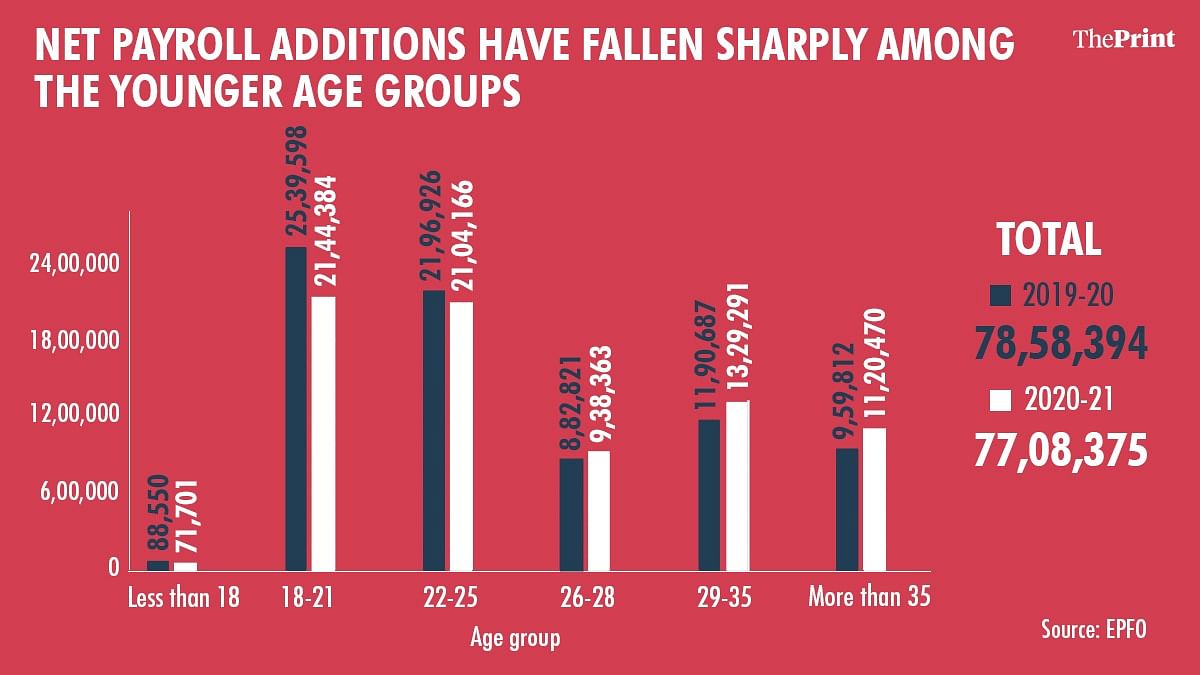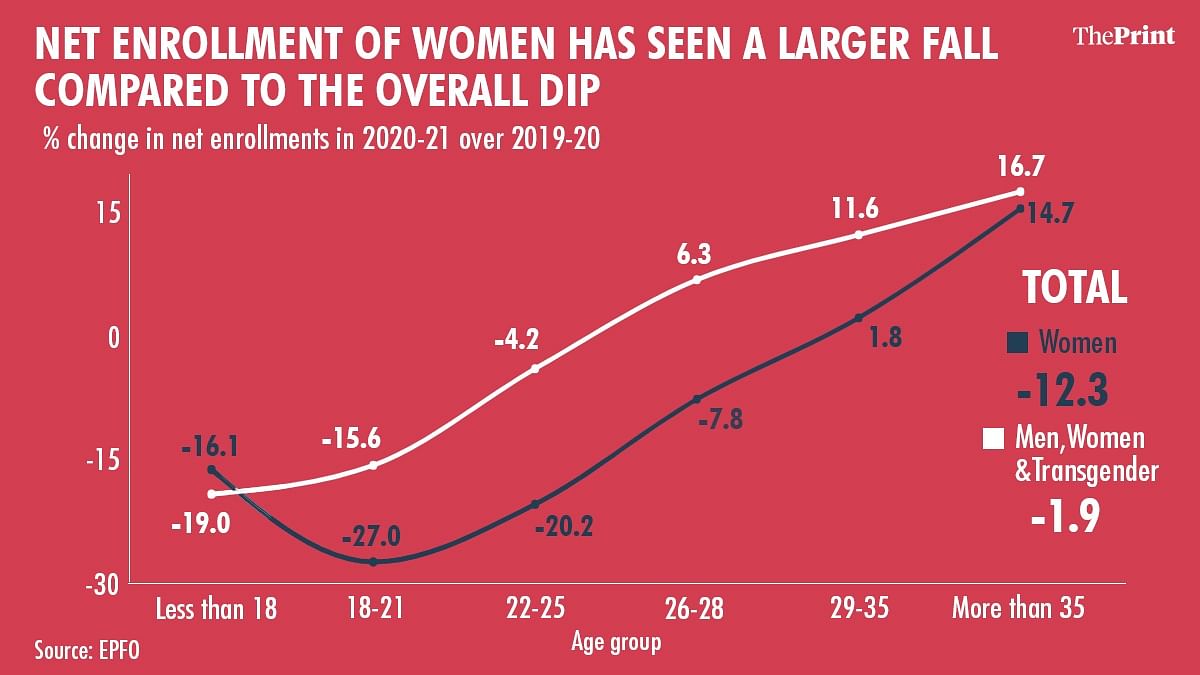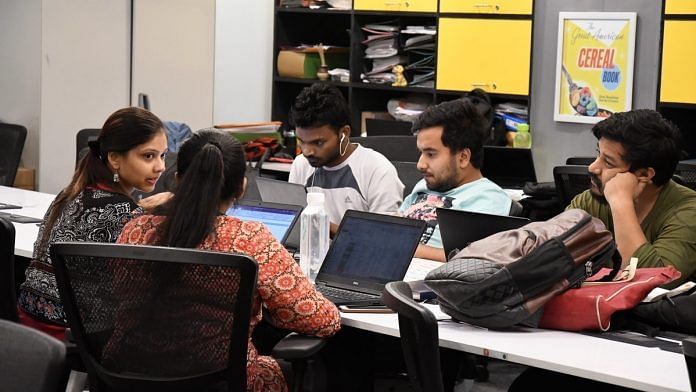New Delhi: India’s younger workforce was the worst hit by the Covid-19 pandemic in 2020-21, payroll data from the Employees’ Provident Fund Organisation (EPFO) showed.
Those aged 25 years or below were among the most affected, with many who lost their jobs during the worst months of the pandemic unable to find employment.
Data for the fiscal 2020-21 showed that there was a fall in the net payrolls for three age categories — under 18, 18-21 and 22-25, on a year-on-year basis as compared to the relatively older age groups. These three younger age groups saw a contraction in payroll additions by 19 per cent, 15.6 per cent and 4.2 per cent, respectively.
In contrast, the 26-28, 29-35 and over 35 years age groups all saw a growth in payroll additions.

Net payroll data is calculated by adding members who are newly enrolled and those who have rejoined after exiting, and after deducting the people who have exited the EPFO.
EPFO manages social security funds of workers in the organised and semi-organised sector in India. Payroll data represents details of employees registered by the firms and includes data of both entry and exits of new employees.
Also read: Kerala retains top rank, Bihar at bottom in Niti Aayog’s SDG India Index 2020-21
Impact on jobs
With the Indian economy coming to a virtual standstill in the first few months of the last fiscal due to a nationwide lockdown, there were severe job losses. While the situation improved over the next few months, data showed that many high quality jobs that were lost haven’t been revived.
Jobs data from the Centre for Monitoring Indian Economy (CMIE) also supported this claim. The cumulative loss of salaried jobs since the pandemic is at 12.6 million, according to CMIE data, with most of the losses in salaried jobs in rural India.
As against 85.9 million salaried jobs in 2019-20, there were only 73.3 million salaried jobs as of April 2021.
“The pandemic has affected both the workers and potential workers. Young and female workers are likely to be far more vulnerable than others. The pandemic has resulted in inequitable labour force outcomes,” said K.R. Shyam Sundar, professor in human resource management, XLRI Jamshedpur.
He pointed out that Covid impacted the services sector including modern retail segments and the gig economy where typically college students get employed. He also added women are less likely to offer themselves in the labour market due to Covid-related issues.
At the same time, fewer firms are also likely to employ women. “Both supply side and demand side factors are responsible for a fall in labour force participation rate of women,” he said.
The EPFO payroll data also shows the disproportionately adverse impact on women. There was a sharp dip in net payroll enrollment for women up to 28 years of age.
The contraction in enrollment in the age groups of under 18, 18-21, 22-25 and 26-28 in 2020-21 was at 16 per cent, 27 per cent, 20 per cent and 7.8 per cent, respectively, much higher than the fall seen in overall payroll additions.

Also read: Modi govt set to begin LIC’s mega IPO process in June
Gap between aspirations and reality has swelled up, say experts
Another reason for the sharp fall among the younger age groups could be the fact that relatively older employees are typically unionised, providing them with greater employment security. This may not be the case for the youth and women who typically are not part of unions or have very low participation, added Sundar.
He, however, cautioned that payroll data comes with its own drawbacks and may not reflect the situation accurately enough.
In a 31 May paper, Ashoka University researchers Ankur Bharadwaj and Kanika Mahajan wrote that the biggest setback of the Covid pandemic was to those age groups that are likely to be composed of first-time labour market entrants or the employed youth.
“The youth, despite their already high unemployment rates, as reported in the PLFS surveys, have perhaps suffered even further with a decline in formal sector jobs. The gap between their aspirations and what is available in the market only seems to have swelled up in the past year. It has set India’s younger workforce back by preventing or delaying their entry into organised employment,” they said.
They pointed out that urban centres, which were major formal sector employment-generating engines, were the worst hit and added that the road to recovery in quality employment is not easy.
According to a State Bank of India research report dated 28 May, employee expenses data for 284 listed companies showed that barring big companies (turnover of over Rs 1,000 crore), employee expenses declined for others in FY21.
“The largest decline was seen in the smallest firms indicating that employees of smaller firms were impacted most due to Covid-19 pandemic,” it pointed out.
The report also estimated that the actual net new payroll (additions due to first jobs) was 44 lakh for 2020-21, around 17 lakh lesser than the new payroll generated in 2019-20.
Also read: With economy reeling under second wave, RBI not expected to change interest rates tomorrow






